#Astrogeology
Text
An international team of researchers, co-led by ETH Zurich and Imperial College London, has derived the first estimate of global meteorite impacts on Mars using seismic data. Their findings indicate that between 280 to 360 meteorites strike the planet each year, forming impact craters greater than 8 meters (about 26 feet) across.
Geraldine Zenhaeusern, who co-led the study, commented, "This rate was about five times higher than the number estimated from orbital imagery alone. Aligned with orbital imagery, our findings demonstrate that seismology is an excellent tool for measuring impact rates."
Continue Reading.
59 notes
·
View notes
Text
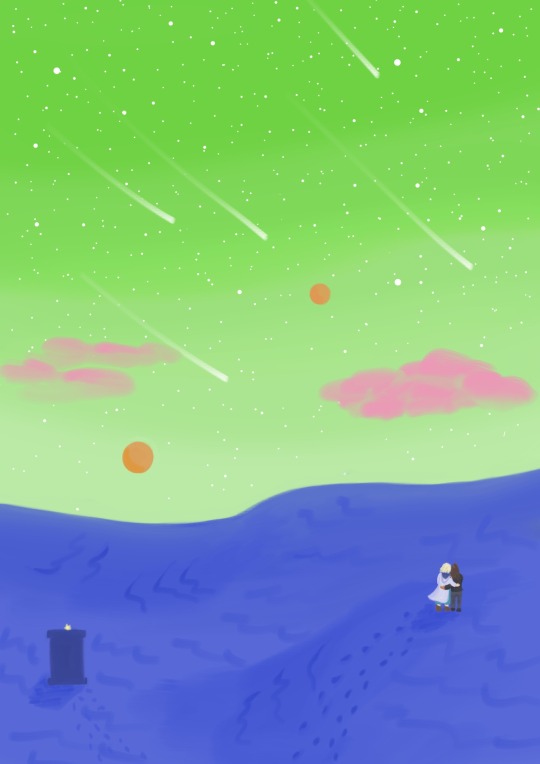
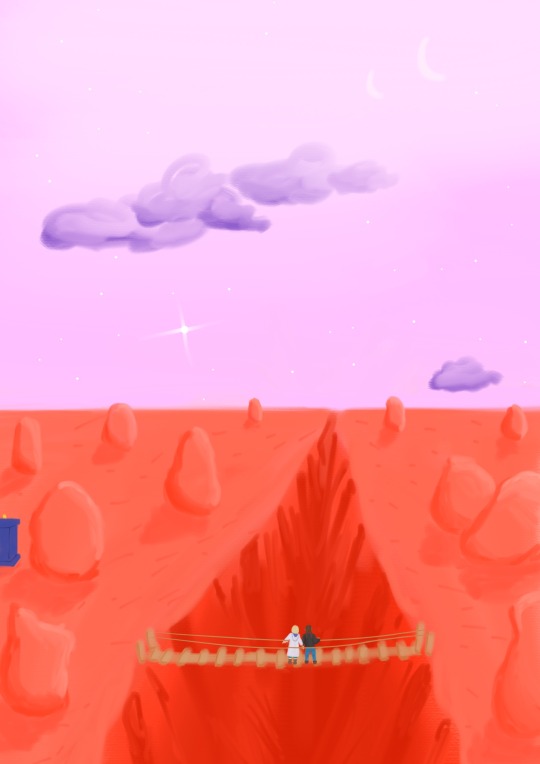
Personally, I, too, long to explore the Universe whilst being gay
#doctor who#thirteenth doctor#yasmin khan#thasmin#my doodles#dw#nuwho#13th doctor#the doctor#digital art#doctor who fanart#dw fanart#thirteen x yaz#alien planet#alien landscape#landscape#stars#exogeology#astrogeology#digital illustration#space#astrobiology#astronomy#painting#digital painting#doctor who art#dw art#exoplanets
65 notes
·
View notes
Text
Continents on Venus!
#Venus#continents#planet Venus#solar system#space#space science#astrogeology#astrogeography#Venusian continents#Venusian geology#Venusian geography#physical geography#planetary science
12 notes
·
View notes
Text






Eugene Shoemaker – Scientist of the Day
Eugene Shoemaker, an American geologist, died on July 18, 1997, age 69, in an accident in Australia.
read more...
#Eugene Shoemaker#astrogeology#planetary geology#Apollo#histsci#histSTM#20th century#history of science#Ashworth#Scientist of the Day
17 notes
·
View notes
Text
Chuck absolutely loves Astronomy, especially Astrometry and Astrogeology. You wanna talk exoplanets and star systems? You wanna know all the names?
He's your guy.
He even founded the Exoplanetology club on Atlantis.
Yup, totally canon.
#Radek made him a custom telescope - engraved and everything#Evan painted his favorite star system on the ceiling in his quarters#Laura will sit there and let Chuck talk for days#she doesn't remember it - but she loves that her bestie is so excited#Rodney goes to Chuck knowing the guy ALREADY named -insert space thing-#and Rodney doesn't have the brain space to remember all of them#John will help him come up with names - Chuck rarely uses them but they both have a good laugh about it#Teyla goes stargazing with him and their club every single time despite not being a member#Ronon enjoys hearing about the crazy planets - Rain's glass? Electric ice ocean? Eternal night with a dead star? Yeah he is here for that.#sga#chuck the technician#chucknician#twotaleshc#astronomy#Astrometry#Astrogeology#Exoplanetology
33 notes
·
View notes
Text
THE UNIVERSE OF SPACE SCIENCE
ASTRONOMY
This galaxy of space science is interested in how stars, planets, and space, basically everything else outside of Earth, operate.
We can divide ASTRONOMY into several solar systems:
ASTROMETRY:
The solar system of astronomy that has an interest in mapping celestial bodies.
THE WORLD(S) OF ASTROMETRY:
☆EXOPLANETOLOGY
This world of astrometry is interested in the number of planets that exist outside our solar system. And where these are located.
ASTROBIOLOGY
This solar system of astronomy is searching for life everywhere else, but Earth.
THE WORLD(S) OF ASTROBIOLOGY:
☆EXOBIOLOGY
This world of astrobiology has an interest in examining the possibility for life to be found and its location in space.
ASTROCHEMISTRY
This solar system of astronomy has an interest in any substance inside a celestial body, star, or a part of interstellar space.
ASTROPHYSICS
This solar system of astronomy will have an interest in the physical laws applied in outer space.
THE WORLD(S) OF ASTROPHYSICS:
☆COSMOLOGY
This world of astrophysics will be interested in the creation, evolution, and fate of the universe.
☆SPECTROSCOPY
This world of astrophysics will be interested in the reflection, absorption, and transference of light between matter.
SOLAR SCIENCE is the moon orbiting the world of astrophysics
*HELIOPHYSICS
This asteroid of solar science will be interested in the sun’s radiation and its effect in the surrounding space.
*HELIOSEISMOLOGY
This asteroid of solar science will be interested in the interior of the Sun, given away from the observation of an oscillation.
SPACE DUST WITHIN HELIOSEISMOLOGY:
1. GLOBAL HELIOSEISMOLOGY is the space dust of helioseismology that will be interested in the study of the Sun's resonant mode.
2. LOCAL HELIOSEISMOLOGY is the space dust of helioseismology that will be interested in the study of the propagation of the component wave near the Sun's surface.
THE WORLD(S) OF ASTROPHYSICS (Continued):
☆ASTEROSEISMOLOGY
This world of astrophysics will be interested in the internal structure of any star through the observation of its oscillation cycle.
☆PHOTOMETRY
This world of astrophysics will be interested in the luminosity of an astronomical object in space based on its electromagnetic radiation.
THE SPECIALIZATION(S) OF ASTROPHYSICS ARE:
1. ATOMIC PHYSICS
Atomic physics is a discipline within astrophysics that will study the atomic structure and the interaction between separate atoms.
2. NUCLEAR PHYSICS
Nuclear physics is a discipline within astrophysics that will study a proton and a neutron at the center of an atom and the interactions that hold them together in a space just a few femtometres across.
3. CONDENSED-MATTER
The study of CONDENSED MATTER is a discipline within astrophysics that will focus on the macroscopic and microscopic physical properties of matter, especially the solid and liquid phase that will arise from electromagnetic forces between atoms. More generally, the subject will study the condensed phase of matter: a system of many constituents with strong interactions among them. A more exotic condensed phase will include the superconducting phase exhibited by certain materials at an extremely low cryogenic temperature, the ferromagnetic and antiferromagnetic phase of spins on crystal lattices of atoms, and the Bose–Einstein condensate found in below freezing atomic systems.
4. PLASMA
The study of PLASMA is a discipline within astrophysics that will examine almost all of the observable matter in the universe found in the plasma state. Formed at high temperature, plasma consists of freely moving ions and free electrons. It is often called the “fourth state of matter” because its unique physical properties distinguish it from a solid, liquid, and gas. Plasma densities and temperatures vary widely, from the cold gases of interstellar space to the extraordinarily hot, dense cores of stars. Plasma densities range from those in a high vacuum with only a few particles inside a volume of 1 cubic centimeter to 1,000 times the density of a solid.
5. SUPER-FLUIDITY
The study of SUPER-FLUIDITY is a discipline within astrophysics that will examine the characteristic property of a fluid with zero viscosity, which could flow without any loss of kinetic energy.
6. GENERAL RELATIVITY
The study of GENERAL RELATIVITY is a discipline within astrophysics that will examine GRAVITY, a fundamental force in the universe. Gravity does define macroscopic behavior, which will describe large-scale physical phenomena. General relativity does, however, follow from Einstein’s principle of equivalence: on a local scale. It is impossible to distinguish between a physical effect due to gravity and those due to acceleration. Gravity is regarded as a geometric phenomenon that could arise from the curvature of space-time.
7. QUANTUM-FIELD THEORY
8. STRING THEORY
ASTROGEOLOGY
This solar system of astronomy will have an interest in the study of rocks, terrain, and material in space.
THE WORLD(S) OF ASTROGEOLOGY:
☆EXOGEOLOGY
This world of astrogeology will study how geology would relate to celestial bodies like moons, asteroids, meteorites, and comets.
☆SELENOGRAPHY
This world of astrogeology will study how any physical feature on the moon formed, such as the lunar maria, craters, and the range of mountains.
4 notes
·
View notes
Text
The Perseverance Mars rover spotted a unique striped rock on Mars. The rock band the White Stripes disbanded in 2011 but Mars, it seems, didn’t get the memo.
#sketch#comedy#satire#funny#joke#mars#perseverance#rock#music#white#stripes#white stripes#striped rock#geology#astrogeology#sketch comedy#space
1 note
·
View note
Text
Researchers prove 120-million-year-old volcanic activity on the moon
Extensive geologic evidence of ancient volcanic activity can be found on the Moon, but how long this volcanism persisted has been unclear. However, Prof. LI Qiuli’s Lab at the Institute of Geology and Geophysics of the Chinese Academy of Sciences (IGGCAS) has recently identified three volcanic glass beads from lunar soil samples collected by the Chang’e-5 mission. Their research shows that the…
0 notes
Link
We've spoken about indirect career paths, but Professor Gretchen Benedix calls hers the pinball method, starting on a course that could change direction when she strikes something that she'd like to delve more into. This method has served Gretchen well and has given her opportunities to work with Dr Sally Ride, the first American woman in space, chase fireballs over the desert, hunt meteorites in Antarctica, and even get an asteroid named after her.
Join us as we speak with Gretchen about her journey to astrogeology, discovering how the solar system evolved, and the Desert Fireball Network.
About Professor Gretchen Benedix
Gretchen Benedix is a Professor (and former Australian Research Council Future Fellow) in the School of Earth and Planetary Sciences at Curtin University. She is also a member of the Space Science and Technology Centre, the largest research group dedicated to Planetary Science in the southern hemisphere.
She is a fierce STEM and Women in Science advocate and takes her responsibility as a role model very seriously. She uses her work to inspire young people and pass along her passion for understanding our Solar System.
Gretchen's research interests lie in the study of meteorites to understand and unravel the evolution of the Solar System. She and her team are currently interested in using machine learning techniques to extend our ability to interact with big datasets, specifically looking at the numbers of craters on other planetary surfaces.
Gretchen wants to understand how the Earth fits into the history of the Solar System.
… And also, she love rocks…
Gretchen has a broad educational background in Geology, Engineering, and Physics, which lets her pull together multidisciplinary ideas to unravel the mysteries of the rocks.
She also loves science communication and has had the opportunity to work at two world-class museums as a planetary scientist, cosmic mineralogist, and astro-geologist, where Gretchen had the pleasure of sharing what she does --- It's just one of the many aspects of her job that she loves - to be able to get other people, especially young folks, excited about studying our solar system and our place in it.
Instagram: @metritedoc
LinkedIn: https://www.linkedin.com/in/prof-gretchen-benedix-155106a/
Watch or listen on your favourite platform.
Show Notes
[00:01:38] How one gets an asteroid named after them.
[00:04:56] Gretchen's journey began in psychology.
[00:06:52] The transition from psychology to physics was not smooth sailing.
[00:08:29] The slow drift into space and getting hooked on rocks.
[00:11:35] The beauty of geology.
[00:16:19] Being flexible gives you the space to be open to opportunities.
[00:18:34] Looking to space because you can't look inside the Earth.
[00:22:41] Comparative planetology and looking at our system in context.
[00:26:49] Context and time scales.
[00:28:59] The engineering in space travel.
[00:32:48] The Desert Fireball Network.
[00:36:42] Location, location, location.
[00:38:31] Tying it back to their origins and the solar system.
[00:40:35] Meteorite families.
[00:43:47] Surprising learnings so far.
[00:46:47] The two-body problem.
Follow STEAM Powered
YouTube
Facebook
Instagram
Twitter
Patreon
#CosmicMineralogy#AstroGeology#space#geology#DesertFireballNetwork#GlobalFireballObservatory#SolarSystem
1 note
·
View note
Text
so are we gonna talk about the fact that there's a fucking huge crater on Mars called the Gale Crater, or

#gale dekarios#bg3#me minding my own business doing my astrogeology homework and suddenly. fucking. gale crater#WELL IF YOU'RE GONNA BLOW UP MARS SURE IS A CONVENIENT PLACE TO DO IT I GUESS#sorry i have. such brainrot.#i just saw this and started absolutely cracking up
5 notes
·
View notes
Text
Sleet
I'm still catching up on tags & trick or treat asks but I wrote a little scene for a discord thing, so have a mini Zalen and Silas scene from back when they were in college:
Zalen's boots crunched in the slush at the end of the crosswalk, that liminal space that the city should clear, but usually didn't bother to. Two storefronts down, he pushed into the blessed warmth of Clarette's Cafe and found a seat at a small table against one wall. It felt good to finally strip off his winter wear after being stuck wearing it in his own apartment. With his hat off he took a moment to pull his dark hair back into a ponytail to get it out of his face.
Clarette appeared a few minutes later, after he'd also gotten out his laptop. "Where's Silas?"
"Invoking tenants' law at the landlord," he said.
"Why are you here, then?"
"Turns out the landlord's office is also freezing. Silas told me to go warm up my hands."
"You want a tea?"
"Yeah, selrus."
"Yeah, I know." Clarette disappeared again and he tried to focus on the article he was supposed to be reading for class. It should have been interesting, but they had to say everything in the most official, convoluted fashion, and this one didn't even have charts for him to skim through. When his tea arrived, in an old mug with a web of cracks over the enamel, he wrapped his bloodless hands around it and let himself look away from his laptop screen. Sleet slashed across the view out the front windows, and he fancied he could hear it on the roof, several stories above his head. It made him cold to look at, so he resumed pretending not to be falling asleep in front of the article.
When he was halfway through his tea, the door chimed, and he glanced up to see Silas wiping his boots on the mat. The fact that he was here so soon meant that the landlord had finally decided to fix the heat, they were actually going to have to sue the landlord, or perhaps worst of all, the landlord had buckled only when threatened with the endless resources of the Natnick family. Anxiety crept up in his gut as Silas came over to join him.
"He's going to fix the heat," Silas said as he pulled his hat off his loose blonde curls. "Today, if possible."
"How did you get him to do that?" Zalen asked.
"I told him I was going to call in a city inspector. And kind of heavily implied that I was friends with one and could get them in there today."
"Are you?"
Silas grinned and shook his head.
#one day I shall complete the TFA powerpoint and you'll know more about these guys#but anyway Zalen has raynaud's bc I have raynaud's so. warm hands is Important#Silas has a weird relationship with his (very rich) family and tries not to invoke them#Silas is in architecture school. Zalen is getting his degree in astrogeology. they are roommates#c: Silas#c: Zalen#c: Clarette#rose writ
0 notes
Text

I just like drawing her being happy:)
#13th doctor#my doodles#the doctor#doctor who#dw#nuwho#thirteenth doctor#exogeology#alien landscape#alien planet#astrogeology#dw fanart#doctor who fanart#jodie whittaker
47 notes
·
View notes
Text
The Crater Farm

An image of the crater farm in the Lavinia Planitia region on Venus, captured by NASA’s Magellan probe
Source
#planet venus#Magellan probe#NASA#Lavinia Planitia#planetary science#astrogeology#planetary geology#planetary geography#planets#Venus#crater farm#national aeronautics and space administration#craters#venusian craters
127 notes
·
View notes
Text
50 Years Ago: Apollo 17
Not long after midnight on Dec. 7, 1972, the last crewed mission to the Moon, Apollo 17, lifted off with three astronauts: Eugene Cernan, Harrison Schmitt, and Ronald Evans.
Experience the Apollo 17 launch and follow the mission in real time.
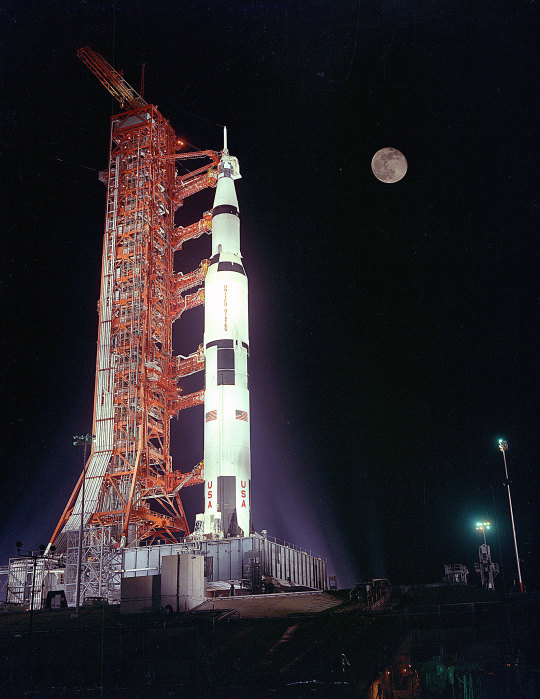
Meet the Crew
Let’s meet the astronauts who made the final Apollo trip to the Moon, including the first scientist-astronaut.
Gene Cernan: In 1972, Apollo 17 Mission Commander Eugene A. Cernan had two space flights under his belt, Gemini 9 in June 1966, and Apollo 10 in May 1969. He was a naval aviator, electrical and aeronautical engineer and fighter pilot.
Ron Evans: Apollo 17 Command Module Pilot Ronald E. Evans was selected as a member of the 4th group of NASA astronauts in 1966. Like Cernan, he was an electrical and aeronautical engineer, and naval aviator before his assignment to the Apollo 17 crew.
Harrison (Jack) Schmitt: Lunar Module Pilot Dr. Harrison (Jack) Schmitt joined NASA as a member of the first group of scientist-astronauts in 1965. Before working for NASA, Schmitt was a geologist at the USGS Astrogeology Center. He was on the backup crew for Apollo 15 before being selected for the prime crew of Apollo 17. He became the first of the scientist-astronauts to go to space and the 12th human to walk on the Moon.
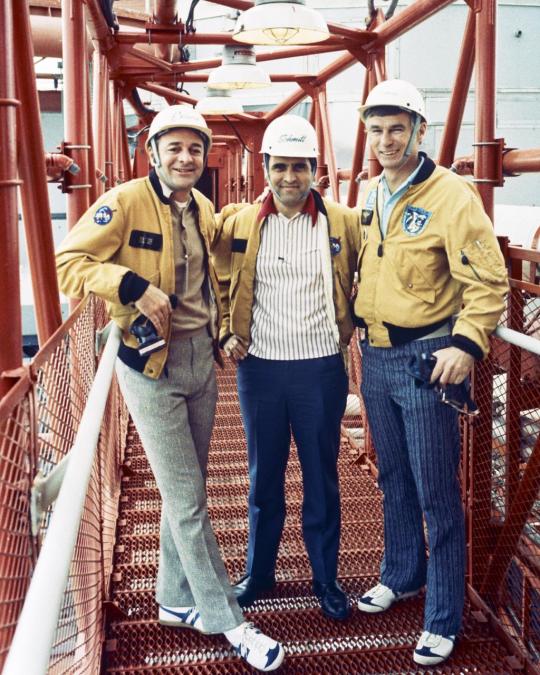
The Blue Marble
“The Blue Marble,” one of the most reproduced images in history, was taken 50 years ago on Dec. 7, 1972 by the Apollo 17 crew as they made their way to the Moon.
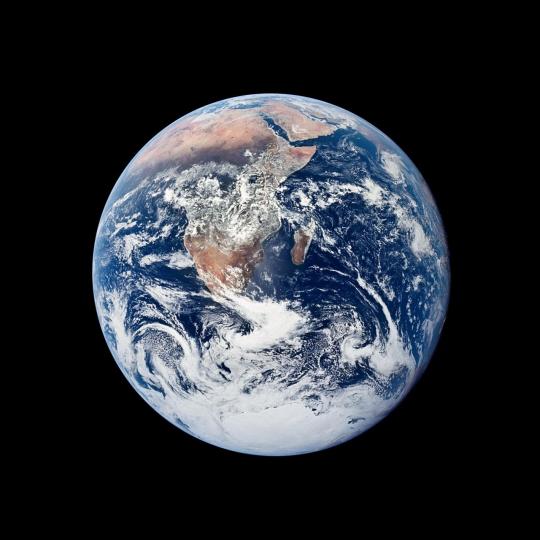
Bag of Soup, Anyone?
NASA astronauts have an array of menu items to stay well fed and hydrated on missions. For Apollo 17, the menus allocated around 2,500 calories per day for each astronaut. They included:
Bacon Squares
Peanut Butter Sandwiches
Frankfurters
Lobster Bisque
Like anything going to space, weight and containment matter. That's why the Apollo 17 menu included plenty of soups and puddings.
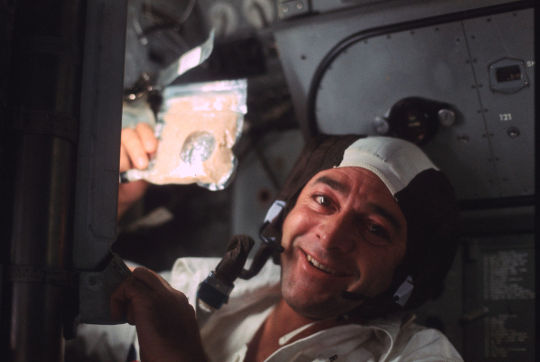
Synchronicity
On Dec. 11, 2022, the Artemis I mission will be splashing down on Earth after its 25.5-day mission. At 2:55 p.m. 50 years prior, the Apollo 17 lunar module (LM) landed on the Moon, with Commander Gene Cernan and LM Pilot Harrison Schmitt on board. Ron Evans remained in the Command and Service Module (CSM) orbiting the Moon.
Experience the landing.
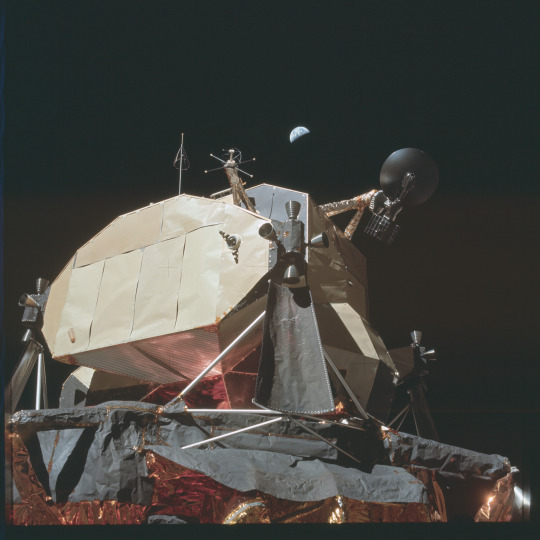
Planting the Flag
One of the first tasks the Apollo 17 crew did on their first moonwalk was to plant the American flag. There’s no wind on the Moon, but that doesn’t mean the flag has to droop. Did you know that a horizontal rod with a latch makes the flag appear to be flying in the wind? Gene Cernan carefully composed this photo to get Schmitt, the flag, and the Earth in a single shot.
So, is the flag still there? Images of the Apollo 17 landing site from the Lunar Reconnaissance Orbiter Camera show that in 2011 the flag was still standing and casting a shadow!
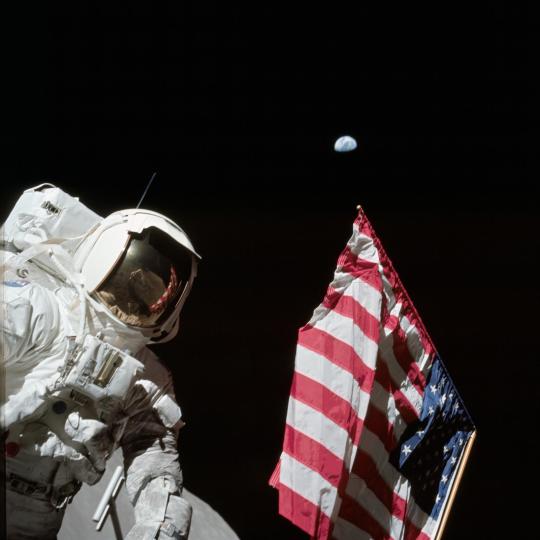
Moon Buggy
During Apollo 17, the Lunar Rover Vehicle (LRV), nicknamed the Moon buggy, logged the farthest distance from the Lunar Module of any Apollo mission, about 4.7 miles (7.5 km).
As a precaution, the LRV had a walk-back limit in the event of an issue; astronauts had to have enough resources to walk back to the lunar module if need be.
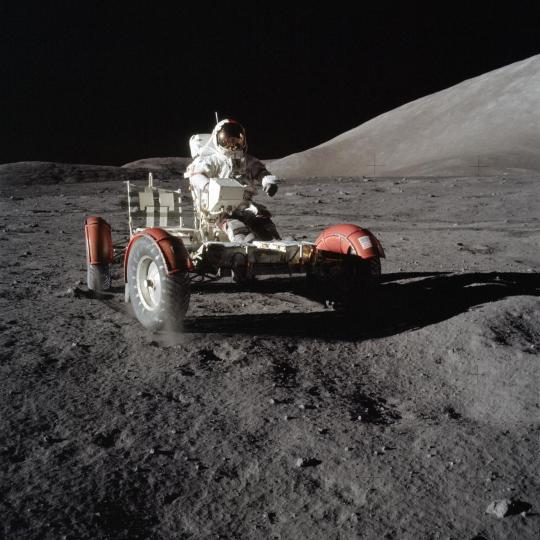
Grab the Duct Tape!
The right rear fender extension of the LRV (Moon buggy) was torn off, kicking up dust as the crew drove, reducing visibility. The crew made a resourceful repair using duct tape and maps.
For LRV fans, visiting an LRV driven on the Moon is a bit difficult since all three LRVs used on the Apollo 15, 16, and 17 missions were left on the Moon. But you can find an LRV used for training at the National Air and Space Museum in Washington.
Read more about the LRV.

The Perils of Lunar Dust
After the first lunar EVA, Apollo 17 astronaut Harrison Schmitt reported that he suffered from “lunar hay fever” in reaction to the lunar dust. Unlike Earth’s dust particles which are rounded, Moon dust particles are sharp and abrasive, irritating astronaut eyes, nasal passages, and lungs.
Curious about how Moon dust feels and smells? Find out!

So What’s it Like?
After his return to Earth, Apollo 17 astronaut Harrison Schmitt (on the right) described his time on the Moon:
“Working on the Moon is a lot of fun. It’s like walking around on a giant trampoline all the time and you’re just as strong as you were here on Earth, but you don’t weigh as much.”

Splashdown!
After 12 days and 14 hours in space, the Apollo 17 astronauts splashed down in the Pacific Ocean at 2:25 p.m. EST on Dec. 19, 1972. It was the longest of all the Apollo missions, with the most photos taken. A recovery team was waiting on the USS Ticonderoga just 4 miles (6.4 km) away to pick up the astronauts, the lunar samples, and the Crew Module.
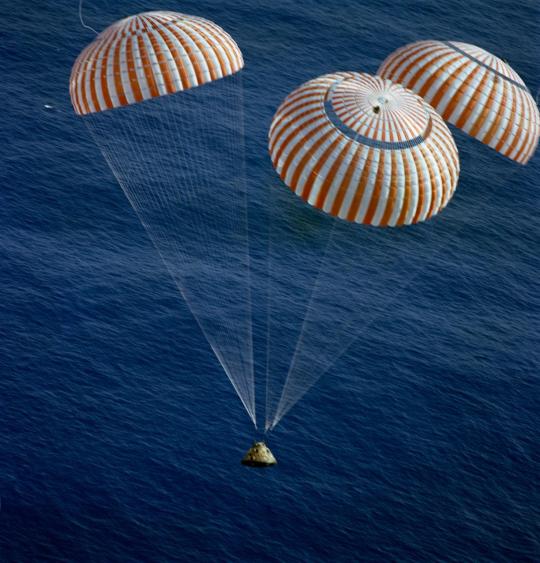
When Are We Going Back?
NASA’s Artemis Program has taken its first steps to sending humans back to the Moon with Artemis I, currently on its way back to Earth. The program plans to land humans, including the first women and person of color, on the Moon’s south polar region with its Artemis III mission, currently slated to launch in 2025.
Is aerospace history your cup of tea? Be sure to check out more from NASA’s past missions at www.nasa.gov/history.
Make sure to follow us on Tumblr for your regular dose of space!
2K notes
·
View notes
Note
For the music thing! 11!! That’s my lucky number hehehe
11- astronauts by rachel platten (also asked by an anon!)
for magicapple 🍎 happy happy endings
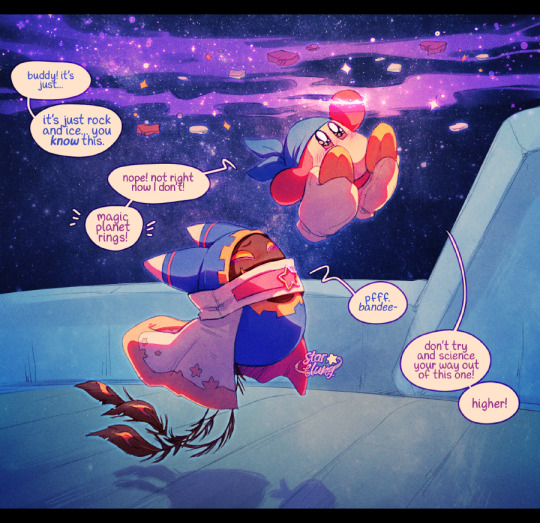
Let's meet up far away where astronauts and g r a v i t y
Have opened up the atmosphere, we'll be so safe up here
Navigating the space we'll create our own star
And I'll name it after you
My, suddenly the stars are flashlights
The u n i v e r s e will make your eyes shine
Can't you feel the way that time stops?
Everything that hurts drops off
hahahahaaaaa ohhhhh this was The One i was most embarrassed about someone finding so great job!!! it's the cheesiest possible song i have for them but it is unfortunately so so perfect and it's one of my favourites. the final bridge regularly makes my eyes water
this song, with its narrative of escaping together and hiding away from things that hurt you both ("there are places up here we can hide//we'll be safe way up high") and that escape being in the sky/space in particular has an extremely strong link to awtdy au, where as things get worse and worse they wear the dream of running away to the stars together so thin it is practically transparent. additionally the 'create our own star' line is sooooo specific and yet!? honestly i did a double take when i found this track!
so yes. extremely cheesy but... if you like some poppy tooth-rotters in your ship, this is a great great song for it!
and regarding the picture itself: despite everything, they are happy in the end, i promise.
i do think whether it's more canon compliant or in an au, bandee is determined to reignite magolor's sense of wonder. he is, imo, just as smart and driven as magolor, if a little less ambitious. in awtdy au in particular bandee learns everything from astronautics to blacksmithing to microelectronics to astrogeology with great enthusiasm!
however unlike magolor, bandee knows how to turn these off in order to just relax or delight in things- like planetary rings- and he's going to make magolor remember how to do this too; even if it takes several dozen years 🍎
#jojoooo i hope you don't hate this i'm so sorry that this cheesiness was what your lucky number netted you 😭#i actually already had this sketched out to this song way back so... it was nice to have the excuse to finally polish it up!#this challenge has actually whupped me into finishing a few things which is good!#awtdy au#asks#music#my art#bandana waddle dee#magolor#magicapple#bandalor
175 notes
·
View notes
Photo

Gates of HellOddly shaped lava formations look like a mass of twisted bodies.Location: Hawaii over the West Kamokuna lava skylightPhoto: The photo was shot in 1996 by Laszlo Kestay, who is currently director of the USGS Astrogeology Science Center.
115 notes
·
View notes